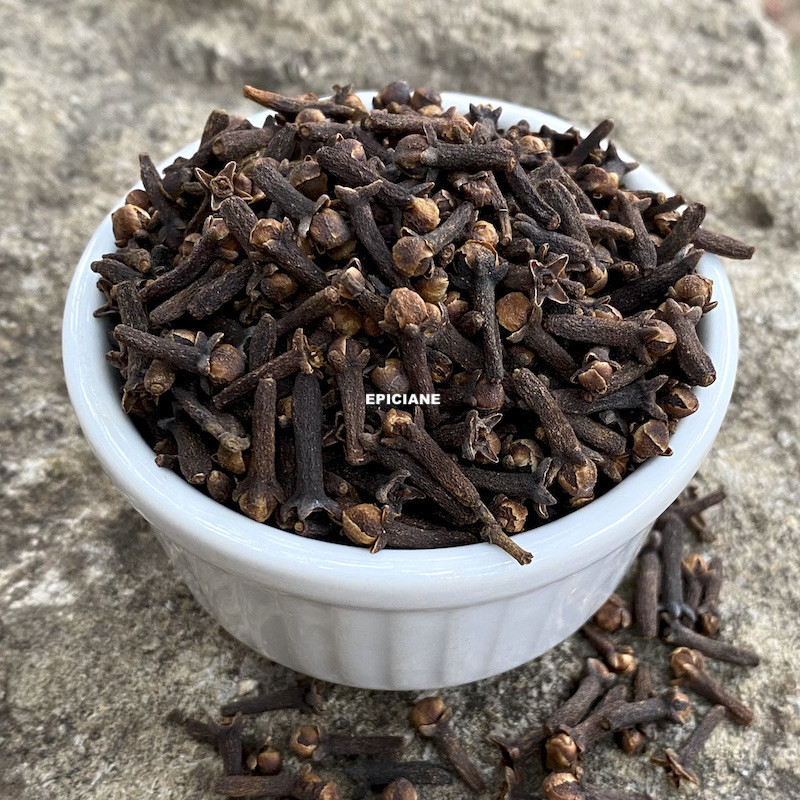
Reference: 1N6987004


With its powerful and unmistakable aroma, cloves evoke a sense of travel.
This spice is essential for marinades, broths, sauces, and also makes a beautiful decorative element.
 Delivery
Delivery
Mondial Relay
 Returns
Returns
See conditions
 Payments
Payments
100% secure
- Livré en sachet refermable -
Uses in Cooking and Beyond:
Cloves are often inserted into an onion to flavor broths for both meats and fish. They also add a wonderful aroma to marinades, sauerkraut, and even teas. In northern and eastern regions during winter, cloves are traditionally stuck into an orange until it is fully covered, then hung in wardrobes with pretty ribbons to ward off insects, especially moths. The orange dries without rotting thanks to the antiseptic properties of cloves, subtly perfumes the wardrobe, and creates a charming decoration.
Ground cloves are used in spice blends for gingerbread, biscuits, certain curries, meats, and charcuterie, often as part of the "four-spice" mix, in which ground cloves are indispensable.
The shiny leaves of the clove tree are also useful, as they are used to extract an essential oil rich in eugenol, a key component in the production of artificial vanillin.
Who am I?
Origin: The Comoros
Scientific name: Eugenia caryophyllus
Cloves are actually the flower buds of the clove tree, a conical tree from the Myrtaceae family, native to the Moluccas archipelago in Indonesia. A mature tree can reach up to 20 meters in height. Its evergreen leaves are oval and leathery. The flowers, with four pale pink petals, are characterized by their deep red sepals. They are fragrant and arranged at the tips of branches. The unopened flower buds, called "cloves" due to their resemblance to a carpenter’s nail, are harvested before they bloom and are sun-dried until they turn dark brown.
Today, Indonesia remains the largest producer of cloves worldwide. However, the tree is also grown in Réunion Island, Madagascar, Zanzibar, and the Caribbean. The lower the rainfall, the better the harvest. A mature tree yields about 6 to 16 kg of cloves per year.
Cloves are antiseptic and anesthetic, which is why they are widely used in dentistry and are effective in relieving toothaches. For sudden dental pain, chewing a few cloves and applying them as a paste to the painful area can provide significant relief. Although this doesn't replace a visit to the dentist, it helps in the meantime!
Cloves are also a key ingredient in khol, a black eyeliner used for eye makeup.
In recent years, clove prices have soared because 95% of the global production is now used to make kreteks, Indonesian cigarettes, falsely marketed as safer for health. This high demand has led to a scarcity of cloves and skyrocketing prices!
A Little History :
Indian writings from 200 BC already mention the trade of this spice. The Chinese also used cloves as early as 206 BC, chewing them for better breath and medicinal benefits. The ancient Greeks and Romans were familiar with cloves as well.
In Europe, cloves were introduced by the Arabs in the 4th century AD, and this spice became very fashionable during the Middle Ages. It was during this time that spices, including cloves, were added to improve what were probably mediocre wines, leading to the creation of the first "hypocras" spiced wines.
The Portuguese, who arrived in the Moluccas in 1424, monopolized clove production by burning trees located outside Ternate, where they held a monopoly. It was Pierre Poivre, intendant of Mauritius, who managed to take a few clove trees during an expedition and successfully acclimate them first in Mauritius and then in the Caribbean.
Data sheet
 Jean-Philippe L.
Jean-Philippe L.
RAS
 Michèle M.
Michèle M.
parfait

 Jean-Philippe L.
Jean-Philippe L.
RAS
 Michèle M.
Michèle M.
parfait

Reference: 1N6987004
Reference: laurierE
Reference: quatreepices
Reference: 20211003
Reference: 20820902
Reference: 6L5609803
Reference: Harissa
Reference: 20701706
Reference: 3N7153402
Reference: fenouilE
Reference: 00723801
Reference: 00036306-0001
Reference: 208037909
Reference: 208022801
Reference: 10N7738802
Reference: gingembreM
Reference: 30803202
Reference: 3N7137901
Reference: gingembreE

With its powerful and unmistakable aroma, cloves evoke a sense of travel.
This spice is essential for marinades, broths, sauces, and also makes a beautiful decorative element.